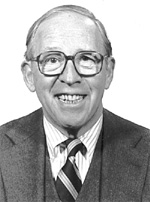Professor Büchi, born on Aug. 1, 1921 in Baden, received a diploma in chemical engineering in 1945 from Eidgenossische Technische Hochschule in Zurich and the DSc in organic chemistry in 1947, working in the laboratory of Professor Leopold Ruzicka.
Professor Büchi was a Firestone Postdoctoral Fellow in the Laboratory of Professor M. Karasch at the University of Chicago for three years before accepting a faculty appointment from MIT in 1951. He was promoted to associate professor in 1956 and to full professor in 1958, and was appointed the Camile and Henry Dreyfus professor of chemistry in 1971 (established in memory of the Swiss-born chemists who pioneered polymer research and founded the Celanese Corp), a position he held until his retirement in 1991. During his tenure at MIT, Professor Büchi trained 70 PhDs and more than l00 post-doctoral students, many of whom have gone on to leadership positions in academia and industry around the world.
Professor Büchi was chosen for MIT's prestigious James R. Killian Jr. Award and Lecture (named after MIT's 10th president) in 1991. At that time, a colleague described him "as one of the best scientists at MIT, and one of the most human." The citation with the award read: "George H. Büchi, MIT faculty member for nearly 40 years, has set an unprecedented standard in organic chemistry. His contributions in research and education have added to the quality of life globally, and his colleagues and students have derived direct benefit from his wisdom, dedication to excellence, and friendship."
Professor Büchi's research made significant contributions in diverse areas of organic chemistry. His work in the 1950s in organic photochemistry was instrumental in converting this latent field into an understandable and useful synthetic tool and laid the groundwork for what is now modern organic photochemistry. He was responsible for the structure determination of over 55 natural products and the synthesis of over 75 complex natural products.
His syntheses were considered creative, elegant and original. In addition, many of his syntheses covered in the over 200 papers from his laboratory were very efficient in producing quantities of the target compound in very few steps. Most notable in the area of molecular toxicology was his work in collaboration with MIT Professor Gerald Wogan on aflatoxins, carcinogenic fungal metabolites initially isolated from spoiled peanuts.
His group not only isolated and determined structures of the toxic compounds, but also completed the total synthesis of many members of the new structural class. He then went on to work with Professors Wogan and John Essigmann to deduce the mechanism responsible for the carcinogenic properties of aflatoxins. Work in the area of molecular toxicology continued with isolation and structures of several mycotoxins and mutagens.
Professor Büchi was elected to the National Academy of Sciences in 1965 and was recognized throughout his career with numerous awards, honorary degrees and lectureships from around the world. He was a highly valued consultant for Hoffmann-La Roche Inc. in both the US and Switzerland and for Firmenich SA in Switzerland and held more than 30 US patents with these companies and on his own.
Professor Büchi is survived by his wife of 43 years, Anne (Barkman) of Cambridge and Jackson, NH; a brother, Heinrich, of Berne, Switzerland, and three nephews, all of whom live in Switzerland. Services were private.
Donations in his memory may be sent to the George H. Büchi Lectureship Fund (established in 1988) at the MIT Department of Chemistry., Room 18-390, 77 Massachusetts Avenue, Cambridge, MA, 02139, Attn: N. Tahsin.






